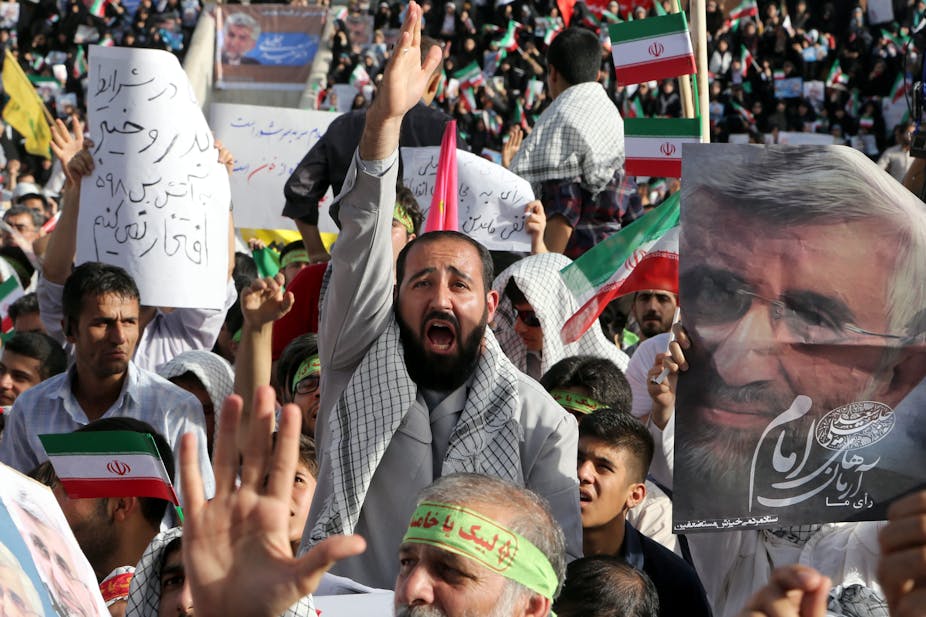Iranian elections have often been the country’s Achilles heel, or as Iranians say, pashneye achil. Since the Islamic Republic of Iran’s inception in 1979, the ruling clergy has incorporated electoral procedures to add another layer of legitimacy to their proclaimed divine sovereignty.
However, the mullahs have found the electoral process difficult to tame. In light of previous experiences, the ruling clerics have taken preventative measures against any surprises in the case of Friday’s presidential elections.
These precautions are specific to the election period and do not play a major role in governance outside of elections. The first significant successful measure was to dissuade former president Mohammad Khatami from running as a candidate.
Iran’s Guardian Council also rejected the nominations of former president Hashemi Rafsanjani and ally of current president Mahmoud Ahmadinejad, Esfandiar Rahim Mashaei, for candidacy. These are two controversial figures who could have sparked a surprise during the election. By implementing these measures the ruling clerics have paid a high price to avoid being caught off guard again and set the stage for one of their favourites to be voted in.
In the last 33 years, the ruling class has been successful in orchestrating over 29 legislative and executive elections (including referenda). These procedures have been used to claim legitimacy for the politico-religious establishment and as a symbol for a seemingly thriving democracy.
But on numerous occasions, elections have offered opportunities for much political, social and religious grievance. The most prominent domestic challenges and threats encountered by the religious establishment seem to arise out of some form of government sanctioned election.
By incorporating elections into their political system, the clergy implanted a peculiar paradox into the theological structure of Iran. Essentially, this paradox consists in the conflict between the appointed and elected institutions.
The most outstanding manifestation of this paradox within the short history of the Islamic Republic of Iran has been the continuing power struggle between the president and the Supreme Leader (the religious title being valey-e faghi).
Pivotally, the power struggle forced the first elected president of the Islamic Republic of Iran (in fact, the first in Iran’s history) Abul-Hassan Banisadr to flee the country in 1981 and seek asylum in France due to problems with the first Supreme Leader, Ayatollah Khomeini.
In 1997, reformist Mohammad Khatami was elected to power over two terms. His presidency was characterised by his disgruntlement with Iran’s second Supreme Leader, Ayatollah Khamenei. Before finishing his second term, and after facing numerous obstacles when trying to instigate reform, Khatami stated that the president is simply an “office coordinator” (tadarokatchi).
And even though Mahmoud Ahmadinejad owes his presidency to Khamenei’s unconditional support during his two elections (2005 and 2009), the same paradox surfaced immediately after he began his second term in office. Over the last few years, external observers have been puzzled by the unexpected power struggle between Khamenei and Ahmadinejad. This puzzle can be understood by considering the aforementioned peculiar paradox involving the Supreme Leader and the president.
In addition to the structural paradox explained above, electoral procedures have also been the catalyst for domestic challenges and threats against Iran’s clerical establishment. Firstly, the phenomenon of elections has given the public rare opportunities for expressing their dissatisfaction and opposition towards the ruling elites.

By voting for Khatami in 1997 - the candidate least favoured by the ruling clerics - Iranians sent the unelected clerics a strong message. These elections have been widely recognised as a symbolic rejection of the social and politico-religious direction of the country. Electoral procedures have also caught conservatives by surprise and galvanised widespread action by the public.
The conservatives learnt many important lessons from the Khatami period and took measures to avoid any surprises in the 2009 elections. As a result, they confirmed the nomination of Mir Hossein Mousavi and Mehdi Karoubi, neither of whom were expected to be able to mobilise widespread support from oppositional sectors of society. However, widespread public dissatisfaction with the government led to the surprising and rapid popularity of Mousavi, who captured the public imagination as the regime’s least favourite candidate.
The announcement of Ahmadinejad’s victory, as favoured by the Supreme Leader, resulted in protests, the likes of which Iran had not experienced since the 1979 Revolution.
These significant events in Iran’s political mosaic are indispensably tied to the phenomenon of elections. Electoral procedures were originally designed as a tool to legitimise the political system and paraded as a badge of honour for the Islamic state. However, the elections of 2009 not only posed an existential threat to the Islamic Republic, but also became the most effective source of delegitimisation of the clerical establishment.
On the eve of the upcoming elections, it is unexpected that some kind of controversy or surprising event will take place. But if previous elections are anything to go by, it is not illusory to assume that something unexpected may occur during or immediately after the election.

